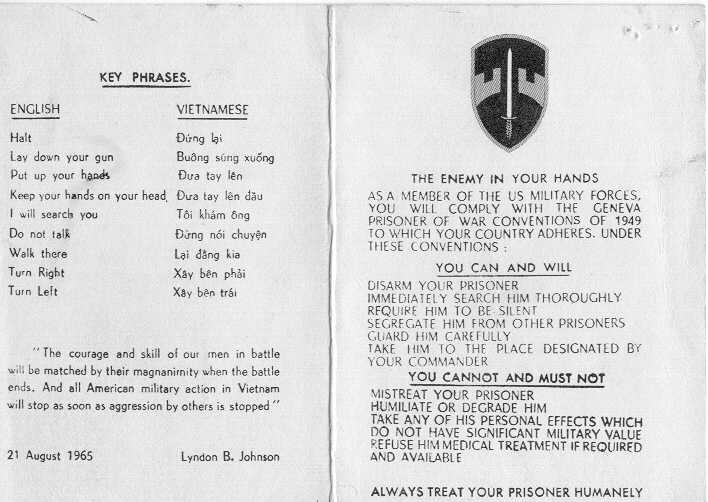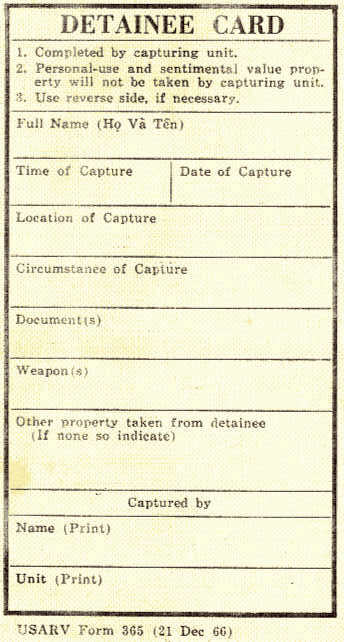Chieu Hoi program information
for the AMERICAL Division area.

A Chieu Hoi leaflet safe conduct pass, with both
sides shown close to the actual size of 6"x3".
The passes were frequently dropped from helicopters
and scattered over suspected enemy
locations in order to encourage enemy soldiers
to surrender as Hoi Chanhs. According to the
AMERICAL Division ORLLs, the average Hoi
Chanh had a wide knowledge of Viet Cong
tactics, including area security procedures,
signs used by the VC, the strength and weapons
of the enemy in the Hoi Chanh's unit area, weapons
caches, and other pertinent operational
intelligence. Hoi Chanhs also had an extensive
knowledge of Infrastructure personalities
residing in his area of operation.
Leaflets scattered from helicopters (over 6 million
in the AMERICAL Division AO in one
month in 1969) and loudspeakers broadcast focused
on several themes. Use of the "Surrender
of Die" ultimatum issued to certain VC and NVA
units only served to instill a more tenacious
will to fight and strengthened opposition to
surrender. The impact on other VC units was more
favorable, probably due to less effective leadership
by the enemy cadre. An alternate approach
to the "Surrender or Die" pitch was a mellowed
appeal to the VC's responsibility to himself and
his family to live. This appeal would be
made after an acknowledgment of his bravery and ability
as a soldier, and then would contain a credible
appraisal of the hopelessness of his situation
and futility in continued resistance. Link
here for the story of helicopter
broadcasts.
Link here for a view of one type of psyop
leaflet , and here for more information about the
psyop
efforts.
Interviews with Hoi Chanhs indicated that the
following underlying causes were instrumental
in persuading them to rally to the GVN:
(a) Growing absence of hard core influence in form of NVA troops
or VC Cadre.
(b) Increased Allied military operations.
(c) Continued food shortage.
(d) Illness and lack of proper medicine.
(e) Breakup of units/cells due to battle losses, ralliers, and disillusionment
with the VC cause.
It was found that proper interviewing of Hoi
Chanhs resulted in information not previously revealed
because they had not been asked specific questions.

The Enemy in Your Hands (USARV GTA No. 21-1 (September
1967), an instruction card from
President Lyndon Johnson to be carried by soldiers
in the field
 |
A
Detainee Card (USARV Form 365 dtd. 21 Dec 66) to be attached to POWs and
detainees in the field as they were sent to the rear.
The
detainee card (4.28"x 2.9") was made of cloth-paper. It was to be
filled out completely by soldiers from the 1st Bn 6th Inf and attached
to enemy POWs, detainees, and Hoi Chanhs. The actual status of the
detainee was determined in the rear area after processing.
If
the detainee card was not available, then even the cardboard from C-rations
boxes could be used for a make-shift tag.
In
1970 and 1971, soldiers in the 1st Bn 6th Inf in the field were not always
certain that the VC they captured in a firefight and sent to the rear were
categorized properly. Some of the VC managed to rip off their tags,
and claimed to be innocent farmers caught in the cross fire. Sometimes
they were subsequently released. The second time that same VC soldier
was caught in a firefight, the "rear" was informed in no uncertain terms
that if they wanted POWs, rather than enemy KIA, they had better categorize
the enemy combatants properly as POWs. This was not an indication
that prisoners would be killed in the field in violation of the law of
war -- it was merely recognition that if VC POWs were mistakenly released,
then the next time more firepower would be expended before any attempts
were made to capture enemy soldiers. |
Select additional photos from the index at left, or link to the 1st
Bn 6th Inf Home Page

